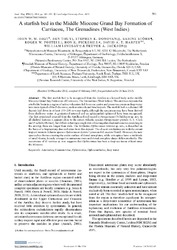A starfish bed in the Middle Miocene Grand Bay Formation of Carriacou, The Grenadines (West Indies)
JAGT, JOHN W. M.
THUY, BEN
DONOVAN, STEPHEN K.
STÖHR, SABINE
PORTELL, ROGER W.
PICKERILL, RON K.
HARPER, DAVID A. T.
LINDSAY, WILLIAM
JACKSON, TREVOR A.
151, 03: 381 - 393
DOI: https://doi.org/10.1017/S0016756813000204
Persistent URL: http://resolver.sub.uni-goettingen.de/purl?gldocs-11858/6917
Persistent URL: http://resolver.sub.uni-goettingen.de/purl?gldocs-11858/6917
JAGT, JOHN W. M.; THUY, BEN; DONOVAN, STEPHEN K.; STÖHR, SABINE; PORTELL, ROGER W.; PICKERILL, RON K.; HARPER, DAVID A. T.; LINDSAY, WILLIAM; JACKSON, TREVOR A., 2013: A starfish bed in the Middle Miocene Grand Bay Formation of Carriacou, The Grenadines (West Indies). In: Geological Magazine, Band 151, 03: 381 - 393, DOI: 10.1017/S0016756813000204.
 |
The first starfish bed to be recognized from the Antilles is a lensoid body in the middle
Miocene Grand Bay Formation of Carriacou, The Grenadines (West Indies). This unit was deposited in
a turbidite basin in a region of active volcanism fed from one centre and preserves common deep-water
taxa more typical of the Palaeozoic, such as crinoids and brachiopods. The starfish bed is a channel-fill
deposit laid down in at least 150–200 m water depth, although the specimens may have been derived
from shallower water. A goniasterid asteroid and an ophiacanthid ophiuroid have been recognized.
The first articulated asteroid from the Antillean fossil record is Paragonaster(?) haldixoni sp. nov. In
all skeletal features it appears close to the extant Atlantic species Paragonaster grandis H. L. Clark
and P. subtilis (Perrier), but differs in having a single row of rectangular abactinal ossicles extending to
the arm tip; these are longer than wide. The brittlestar, Ophiocamax ventosa sp. nov., is described on
the basis of a fragmentary disc and arms from this deposit. The closest similarities are with the extant
tropical western Atlantic species Ophiocamax hystrix Lyman and O. austera Verrill. However, the new
species has thorns covering the entire surface of dorsal arm plates, while arm spines have a multitude
of small thorns, loosely arranged in numerous rows and dorsal arm plate shape differs markedly. The
occurrence of O. ventosa sp. nov. suggests that Ophiocamax has been a deep-sea taxon at least since
the Miocene.

